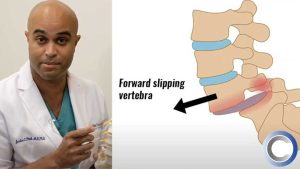Anatomy of the Spine
5 Sections of the Spine
The spine, also known as the vertebral column, is made up of five distinct sections. Each section plays an important role in providing support, flexibility, and protection for the spinal cord. The five sections are:
- Cervical Spine (Neck): The top portion of the spine, consisting of seven vertebrae (C1–C7). It supports the head and allows for a wide range of motion, including turning and nodding.
- Thoracic Spine (Upper and Mid Back): Made up of twelve vertebrae (T1–T12), this section connects to the rib cage and provides stability and protection for vital organs like the heart and lungs.
- Lumbar Spine (Lower Back): Comprising five larger vertebrae (L1–L5), the lumbar spine bears much of the body’s weight and is crucial for movement and lifting.
- Sacral Spine (Pelvic Area): Five vertebrae (S1–S5) are fused together to form the sacrum, a strong, triangular-shaped bone that connects the spine to the hips.
- Coccygeal Spine (Tailbone): Commonly known as the tailbone, this small section consists of three to five fused vertebrae at the very bottom of the spine.
Spinal Cord and Nerve Roots
The spinal cord is a delicate bundle of nerves running from the brain down through the spine. It acts as the body’s main communication pathway, transmitting messages between the brain and the rest of the body. Surrounding the spinal cord, the vertebrae create a protective canal to safeguard this critical structure.
Branching off the spinal cord are the nerve roots, which exit through small openings between vertebrae. Nerve roots carry sensory and motor information to and from specific areas of the body. Injury or compression of these nerves can cause symptoms like pain, numbness, or weakness.
Role of Vertebrae
Vertebrae are the individual bones that stack to form the spine. They serve several important roles in the body. They provide a strong, stable structure that supports the head and body, and protect the spinal cord — a bundle of nerves that runs through the center of the spine and carries messages between the brain and the rest of the body. Vertebrae also allow for flexibility and movement, enabling you to bend, twist, and maintain balance.
Parts of a Vertebra
Each vertebra is made up of several important components that work together to provide strength, flexibility, and protection:
Vertebral Body
The thick, round portion at the front of the vertebra. It bears weight and absorbs shock, with an intervertebral disc sitting between each vertebral body.
Pedicles
Short, strong bridges of bone that connect the vertebral body to the back part of the vertebra. They help form the sides of the spinal canal and provide structural stability.
Lamina
The lamina forms the back part of the spinal canal. It connects the pedicles and protects the spinal cord. In some cases, it may be partially removed in a surgery called a laminectomy to relieve pressure on the spinal cord or nerves.
Spinous Process
The bony projection you can feel along the back of your spine. It serves as an attachment point for muscles and ligaments that support movement and stability.
Transverse Process
Bony projections on either side of the vertebra. They serve as anchor points for muscles and ligaments that help move and stabilize the spine.
Articular Facet
Smooth, joint surfaces where one vertebra connects to another. These facet joints allow the spine to flex, twist, and move while maintaining stability.
Intervertebral Disc
Between each vertebra lies an intervertebral disc — a soft, cushion-like structure made up of a tough outer layer (annulus fibrosus) and a gel-like center (nucleus pulposus). Discs act as shock absorbers, allowing for movement while protecting the vertebrae from wear and tear. Healthy discs are essential for maintaining spine flexibility and function.
FAQs
The lower back (lumbar spine) is the most commonly injured because it supports most of the body’s weight and is heavily involved in movement and lifting.
Each vertebra lines up with a nerve root that controls sensation and movement in specific parts of the body. For example, cervical vertebrae affect the arms and hands, while lumbar vertebrae affect the hips, legs, and feet.
Cervical nerves (C1–C8): Neck, shoulders, arms, hands
Thoracic nerves (T1–T12): Chest, upper back, abdomen
Lumbar nerves (L1–L5): Hips, thighs, knees, lower legs, toes
Sacral nerves (S1–S5): Feet, toes, pelvic organs
These nerves also contribute to sensation in these anatomic regions.
Signs of nerve injury can include numbness, tingling sensations (often described as “pins and needles”), muscle weakness, sharp or burning pain. Symptoms usually appear in the area of the body served by the affected nerve and may worsen over time if not treated.
There are 23 intervertebral discs in the spine.
1. Protect the spinal cord and nerves
2. Support the body’s weight and maintain balance
3. Allow flexible movement like bending and twisting









